Application Gallery
These are some examples of what some of our customers have accomplished with EPIX® products. Most of our customers perform proprietary operations that may not be publicly disclosed, but here are a few that are. Please contact us if you would like your application of an EPIX® imaging product showcased here.
 "The video and pictures shows Time Resolved (TR) PIV results of mechanical properties of the body of a
fish. The study was done to explore the source of high efficiency during fish swimming. Researchers investigated
the viscoelastic properties of the fins, muscle and skin of Crucian carp (Carassius Auratus). Comparison of
these results with the cruising frequency of Crucian carp shows that the dissipation due to internal viscoelasticity
during cruising is small. Microvec PIV system was used for this research with a 1.5W CW semiconductor laser,
Imperx 640 x 480 pixel camera with Epix frame grabber recoding at 170 frames per second."
"The video and pictures shows Time Resolved (TR) PIV results of mechanical properties of the body of a
fish. The study was done to explore the source of high efficiency during fish swimming. Researchers investigated
the viscoelastic properties of the fins, muscle and skin of Crucian carp (Carassius Auratus). Comparison of
these results with the cruising frequency of Crucian carp shows that the dissipation due to internal viscoelasticity
during cruising is small. Microvec PIV system was used for this research with a 1.5W CW semiconductor laser,
Imperx 640 x 480 pixel camera with Epix frame grabber recoding at 170 frames per second."
VISCOELASTIC CHARACTERISTICS OF FINS, MUSCLE AND SKIN IN CRUCIAN CARP
(CARASSIUS AURATUS)
CHEN Ming, JIA Lai-Bing, YIN Xie-Zhen*
University of Science and Technology of China, Hefei, China
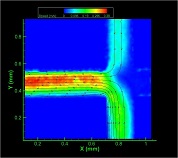 "The images show PIV and LIF results in 200μm wide micro channel. First experiment showing flow characteristics
in two single-phase mixing. Second shows two phase flow characteristics of oil-water mixed measurement. Laser
used for the experiment was double pulse 532 nm Nd:YAG solid-state pulsed laser, 350 mj × 2; 15hz with
pulse width of 6-8 ns. 5 megapixel camera with the maximum sampling rate of 15Hz using double exposure mode
with Epix EB1 frame grabber and MicroPulse725 V5 synchronizer. Maximum speed of the plane was 1m/s and the
special resolution was 0.475 um / pixel. Latest MicroVec 3.5 software was used for the calculations. "
"The images show PIV and LIF results in 200μm wide micro channel. First experiment showing flow characteristics
in two single-phase mixing. Second shows two phase flow characteristics of oil-water mixed measurement. Laser
used for the experiment was double pulse 532 nm Nd:YAG solid-state pulsed laser, 350 mj × 2; 15hz with
pulse width of 6-8 ns. 5 megapixel camera with the maximum sampling rate of 15Hz using double exposure mode
with Epix EB1 frame grabber and MicroPulse725 V5 synchronizer. Maximum speed of the plane was 1m/s and the
special resolution was 0.475 um / pixel. Latest MicroVec 3.5 software was used for the calculations. "
FLOW CHARACTERISTICS IN 200μm MICROCHANNEL MODEL
Wang Xi
Institute of Process Engineering, Chinese Academy of Sciences, Beijing, China
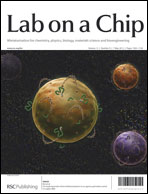 "We used an Epix Silicon Video 642 CCD camera attached to a trinocular inverted microscope with an adapter
for imaging a large protein-coated region while maintaining a high resolution that contains enough detail to
allow tracking of cells over time."
"We used an Epix Silicon Video 642 CCD camera attached to a trinocular inverted microscope with an adapter
for imaging a large protein-coated region while maintaining a high resolution that contains enough detail to
allow tracking of cells over time."
"Each series of images was imported into XCAP v3.2 software (Epix, Inc., Buffalo Grove, IL). XCAP software permits tracking of each cell in successive images."
Determination of single cell surface protein expression using a tagless microfluidic method†
Rajan
Kumar, Sri HariKrishna Vellanki, Robin Smitha and Robert Wieder
Received 30th November 2011, Accepted 27th
February 2012
DOI: 10.1039/c2lc21180g
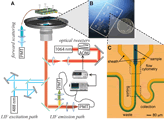 Thomas D. Perroud and co-authors have extended the principle of optical tweezers as a noninvasive technique
to actively sort hydrodynamically focused cells based on their fluorescence signal in a microfluidic device.
This micro fluorescence-activated cell sorter uses an infrared laser to laterally deflect cells into a collection
channel. The movie taken at 400 fps by a monochrome 1000 fps CCD camera (UF-1000CL; Uniq Vision) and saved
at 10 fps by a PIXCI CL1-UF-1000-CL Camera Link Frame Grabber (Epix) shows the optical deflection of a cell
(velocity ~ 20 mm/s) into a different microfluidic channel. Video (WMV).
Thomas D. Perroud and co-authors have extended the principle of optical tweezers as a noninvasive technique
to actively sort hydrodynamically focused cells based on their fluorescence signal in a microfluidic device.
This micro fluorescence-activated cell sorter uses an infrared laser to laterally deflect cells into a collection
channel. The movie taken at 400 fps by a monochrome 1000 fps CCD camera (UF-1000CL; Uniq Vision) and saved
at 10 fps by a PIXCI CL1-UF-1000-CL Camera Link Frame Grabber (Epix) shows the optical deflection of a cell
(velocity ~ 20 mm/s) into a different microfluidic channel. Video (WMV).
Perroud, T. D.; Kaiser, J. N.; Sy, J. C.; Lane, T. W.; Branda, C. S.; Singh, A. K.; Patel, K. D. Microfluidic-Based Cell Sorting of Francisella tularensis Infected Macrophages using Optical Forces. Analytical Chemistry 80, 6365-6372 (2008).
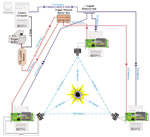 "In this example, the object was to record the detailed behavior of a combustion event—a fire or
explosion—in a large field. Figure 1 shows the arrangement of the major elements of the vision system supplied by EPIX of Buffalo Grove, IL. The
company designed and built the system based on three Basler A504kc Color Cameras and three PIXCI CL3SD Frame
Grabbers."
"In this example, the object was to record the detailed behavior of a combustion event—a fire or
explosion—in a large field. Figure 1 shows the arrangement of the major elements of the vision system supplied by EPIX of Buffalo Grove, IL. The
company designed and built the system based on three Basler A504kc Color Cameras and three PIXCI CL3SD Frame
Grabbers."
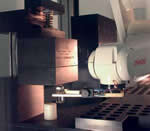 In operation, reflected images from the vials are transmitted through the folded-optic assembly and imaged
by a 1300 × 1030-pixel Camera Link M4+ camera from JAI Pulnix. Interfaced to a PC-based PIXCI CL2 64-bit/66-MHz PCI frame grabber from Epix, images are directly transferred to the host PC
memory for image processing. “The motion control of the system needed to be tightly integrated with the
imaging system,” says Budd.
In operation, reflected images from the vials are transmitted through the folded-optic assembly and imaged
by a 1300 × 1030-pixel Camera Link M4+ camera from JAI Pulnix. Interfaced to a PC-based PIXCI CL2 64-bit/66-MHz PCI frame grabber from Epix, images are directly transferred to the host PC
memory for image processing. “The motion control of the system needed to be tightly integrated with the
imaging system,” says Budd.
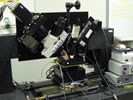 B. H. McCormick, (2002) Knife-edge scanning microscope (KESM) - "Digital video from the multi-tapped linear
CCD array of the CT-F3 camera is delivered via 8 channels at 25MB/s each to a Dell PowerEdge 2550 server. Camera
interface cards (two for the Dalsa CT-F3-4096 line scan camera; one for the Dalsa CL-T5-2048 color line scan
camera) provided by Epix, Inc. store this data in the dual processor." (19 February 2006)
B. H. McCormick, (2002) Knife-edge scanning microscope (KESM) - "Digital video from the multi-tapped linear
CCD array of the CT-F3 camera is delivered via 8 channels at 25MB/s each to a Dell PowerEdge 2550 server. Camera
interface cards (two for the Dalsa CT-F3-4096 line scan camera; one for the Dalsa CL-T5-2048 color line scan
camera) provided by Epix, Inc. store this data in the dual processor." (19 February 2006)
 "The EPIX frame grabber and software will be initially used in a demonstration of the
effects of atmospheric turbulence on the image quality of stars. No doubt it will find many other uses over
the years. One of the important aspects of encouraging high school students to explore scientific endeavors
is giving them the sense that they are doing something new and unique. The EPIX donation goes a long way in
that effort. We will be sure to keep EPIX informed about our progress."
"The EPIX frame grabber and software will be initially used in a demonstration of the
effects of atmospheric turbulence on the image quality of stars. No doubt it will find many other uses over
the years. One of the important aspects of encouraging high school students to explore scientific endeavors
is giving them the sense that they are doing something new and unique. The EPIX donation goes a long way in
that effort. We will be sure to keep EPIX informed about our progress."
Read the entire thank you
note. (PDF)
 "We are using a pair of high-speed digital cameras from DALSA, and frame-grabbers from EPIX,
and rack-mount PCs running LynxOS. After I wrote the device driver for the board for LynxOS, a colleague, Gabriel
Lopes, wrote for us a simple vision system which uses the Kullback measure to dynamically compute a threshold
with which to segment an image. Currently his system can track a features position and orientation in real-time
at 100 frames per second on a modest PII400MHz, with a window size of 128x128 (it may go faster, but this is
as fast as we've tried -- the cameras can do 255Hz)."
"We are using a pair of high-speed digital cameras from DALSA, and frame-grabbers from EPIX,
and rack-mount PCs running LynxOS. After I wrote the device driver for the board for LynxOS, a colleague, Gabriel
Lopes, wrote for us a simple vision system which uses the Kullback measure to dynamically compute a threshold
with which to segment an image. Currently his system can track a features position and orientation in real-time
at 100 frames per second on a modest PII400MHz, with a window size of 128x128 (it may go faster, but this is
as fast as we've tried -- the cameras can do 255Hz)."
Empirical Validation of a New Visual Servoing
Strategy (PDF)
Visual Servoing via Navigation Functions (PDF)
 EPIX®
donated a PIXCI® series board to the University of Cincinnati Robot Team for their use in the Summer 2000
competition.
EPIX®
donated a PIXCI® series board to the University of Cincinnati Robot Team for their use in the Summer 2000
competition.
Bearcat II Design Report 8th Intelligent Ground Vehicle Competition (PDF)
"Design Solution:
A monochrome Panasonic RS170 camera was used to detect simulated potholes. The
data from the camera is passed into an Imaging Board from EPIX Inc. The formatted data from the EPIX Imaging
Board is then processed to detect the presence of a simulated pothole and the centroid location of the pothole,
in case one is present.
First, a threshold operation is performed on the image to obtain a binary image. Then, the noise from the environment is removed by analyzing the blobs in the image. The noise removed image is then processed with a circular regression procedure.
The XCOBJ/PXIPL Image Processing libraries16 provided by EPIX were used extensively for developing the control software." (19 February 2006)
Student research paper in which an EPIX® board is selected and used:
Detection and Avoidance of Simulated
Potholes in Autonomous Vehicle Navigation in an Unstructured Environment (PDF)
 Gunderson R.W., et al,
(2000) The Collective GIS and the Computer-Controlled Farm (PDF) - "Airborne Multispectral Remote Sensing...
The current USU system uses three EPIX frame grabbing and control boards in a special rack-mounted Pentium
PC computer. The boards control the digital cameras, calculating the frequency of image acquisition according
to altitude, speed, and desired overlap between images. The software sets the camera shutter speed and automatically
names and stores the files as they are acquired. GPS-based coordinated universal time is used to colocate the
center of each image with GPS positions acquired at one-second intervals." (24 August 2005)
Gunderson R.W., et al,
(2000) The Collective GIS and the Computer-Controlled Farm (PDF) - "Airborne Multispectral Remote Sensing...
The current USU system uses three EPIX frame grabbing and control boards in a special rack-mounted Pentium
PC computer. The boards control the digital cameras, calculating the frequency of image acquisition according
to altitude, speed, and desired overlap between images. The software sets the camera shutter speed and automatically
names and stores the files as they are acquired. GPS-based coordinated universal time is used to colocate the
center of each image with GPS positions acquired at one-second intervals." (24 August 2005)
Glowa J. (2007) Design and Process/Measurement for Immersed Element Control in a Reconfigurable Vertically Falling Soap Film (PDF) - "Within the included XCAP interface, a user can define such variables as the AOI, pixel clock, exposure time, and multiple gains. After that, a C script is required to grab frames from the imager. The required functions for extracting and saving images from the EPIX board can be found in the XCLIB libraries." (17 August 2007)
Chiesl, T. N., et al. (2006) Self-Associating Block Copolymer Networks for Microchip Electrophoresis Provide Enhanced DNA Separation via “Inchworm” Chain Dynamics (PDF) - "This high-speed camera has an adjustable frame rate of up to 120 frames/s at the full resolution of 648 × 484 pixels. Videos and images are directly captured onto a computer (Dell, 3 GHz processor, 1 Gbyte of memory) via camera link technology to a PIXCI control board (EPIX Inc., Buffalo Grove, IL), and the capture is controlled through XCAPSTD (EPIX Inc.) software." (17 August 2007)
Valeria Garbin, (2006) Optical Tweezers for the Study of Microbubble Dynamics in Ultrasound (PDF) - "The image is collected by a CMOS sensor (Epix, VCA1281 sensor; 1280×1024 maximum resolution, sensor size 8.96mm × 7.17mm, pixel size µ7m × µ7m)." (16 August 2007)
Granular Materials Laboratory - "High-speed photography: A high-speed, long-acquisition digital camera system designed and implemented by Prof. Shattuck. It features 955 frame per second, 256 pixels array camera system based on DALSA CA-D6-0256W camera and Epix PIXCI D32 data acquisition board. In combination with an Adeptec 39160 SCSI disk array controller and six 18GB 10K rpm IBM deskstar hard drives (at 160MB/s sustained transfer rate), the system is capable of full frame rate acquisition for up to 20 minutes or one million frames with no data loss. This gives six orders of magnitude of temporal dynamic range.
By storing to hard disk array it can achieve 108GB at 160MB/s and can be upgraded if needed to 570GB at 200MB/s. Typically, commercial systems have limited acquisition times due to frame capture to RAM. Since the system is constructed using standard components, custom software had to be developed to take proper advantage of the system." (17 August 2007)
Zhang, R., (2005) Mechanical characterization of thin films with application to ferroelectrics (PDF) - "The pictures from the CCD camera are recorded on a computer using a frame grabber card (EPIX, PIXCI SV4)." (17 August 2007)
Akira Tokuhiro and Shreekanth Vadakattu, (2005) Inpecting a Research Reactor's Control Rod Surface for Pitting Using a Machine Vision Approach (PDF) -
- "After capturing images at different intensities of light, XCAP-Std software is used to identify the image that reveal maximum number of pits."
- "XCAP-Std has a Blob Analysis features which recognizes blobs as pits on the images and generates output report containing number of blobs."
- "Blob Analysis feature in XCAP-Std identifies image blobs based on segmenting the image into foreground that is blob and background."
(19 February 2006)
Wu, F., and Yang K. (2004) A stochastic partial transport model for mixed-size sediment: Application to assessment of fractional mobility (PDF) - "The 1300x1030 pixels resolution of the CCD camera enabled us to create pictures suitable for the image analysis. The recording device, interfaced by PIXCI D2X imaging board, was connected to a data logging system .. serving to store an extremely huge amount of motion-picture images taken during a transport event." "The digital images were analyzed with the aid of the XCAP software for evaluating the mean particle velocity.." "This was done with the aid of the blob analysis featured by the XCAP software, which can segment the blobs from the background by the specified target color." "With the function of particle tracking of the XCAP software, the grain trajectory was traced." (10 June 2005)
M.V. Kameneva et al. (2004) Blood soluble drag-reducing polymers prevent lethality from hemorrhagic shock in acute animal experiments (PDF) - "Images of RBCs flowing through the microchannel were recorded by using a digital high-resolution CCD camera (1328 × 1024 pixels, Kodak Megplus 1.4) and an image acquisition board (PIXCI, EPIX Inc., IL) hosted in a computer. " (17 August 2007)
Dell’Aquila, A. (2004) Seed Germination & Computer Imaging "The computer image analysis unit consists of the following basic components: a digital camera Silicon Video 2112 CMOS and a PIXCI D2X imaging board ( both purchased from EPIX, USA)..." (10 June 2005) See also.. Application of a Computer–Aided Image Analysis System to Evaluate Seed Germination under Different Environmental Conditions (PDF)
Endoprobe Project - "The video signals from the endoscope's camera are captured using a high-speed video capture card (EPIX Corp., Model PIXCI SV5) mounted in a PCI slot of the personal computer. The capture rate of the card is 30fps, allowing real-time video display." (10 June 2005)
Aleman, T. S. (2004) Impairment of the Transient Pupillary Light Reflex in Rpe65-/- Mice and Humans with Leber Congenital Amaurosis (PDF) - "The second computer contained a video digitizer (PIXCI SV4 board, ver. 2.1; Epix, Inc., Buffalo Grove, IL) which produced a video sequence." (9 June 2005)
Fuchs, H. L., et al. (2004) Sinking behavior of gastropod larvae (Ilyanassa obsoleta) in turbulence (PDF) - "Larval video records were digitized using an EPIX PICXI SV5 image capture board with XCAP-Std software." (10 June 2005)
Lima-Ochoterena, R. and Zenit, R. (2003) Visualization of the flow around a bubble moving in a low viscosity liquid (PDF) - "Once the motion of the bubbles was obtained, the images were transferred into a computer using a frame grabber (EPIX Inc. card)." (9 June 2005)
Smirnov, A., et al. (2004) Mucin Dynamics in the Chick Small Intestine Are Altered by Starvation - "All measurements were performed with an Olympus light microscope using EPIX XCAP software." (10 June 2005)
Wilde, T. P., (2004) An Energy Based Model for the Compressive Behavior of Goose Down (PDF) - "Images were captured to a PC using the Epix Inc. XCAP Lite software." (10 June 2005)
Smith, E. A., et al. (2003) Surface Plasmon Resonance Imaging Studies of Protein-Carbohydrate Interactions (PDF) - "All SPR Images were collected using the software program XCAP v1.0 (EPIX Inc.)." (10 June 2005)
Goh, J. B. (2003) A quantitative diffraction-based sandwich immunoassay (PDF) - "A Silicon Video 2112 CMOS camera controlled by a PIXCI D2X digital capture board and XCAP-STD software (all from EPIX) were used because they permitted the automated capture of images and more streamlined processing of data." (9 June 2005)
Ekani-Nkodo, A. and Fygenson D. K. (2003) Size exclusion and diffusion of fluoresceinated probes within collagen fibrils (PDF) - "Images were recorded directly to computer RAM via a CCD (1310 camera, DVC) and a frame grabber (Pixci, Epix) using the software control package XCAP (Epix)." (9 June 2005)
Kameneva, M. V., et al. (2003) Blood soluble drag-reducing polymers prevent lethality from hemorrhagic shock in acute animal experiments (PDF) - "Images of RBCs flowing through the microchannel were recorded by using a digital high-resolution CCD camera (1328× 1024 pixels, Kodak Megplus 1.4) and an image acquisition board (PIXCI, EPIX Inc., IL) hosted in a computer." (9 June 2005)
Hovermann, F. (2003) Development of a New Apparatus to Measure Flame Spread Through a Free Stratified Fuel/Air Mixture: Numerical Modeling and Experimental Results (DOC) -"Frame grabber - Epix PIXCI-SV4 - Capture and digitize images. Software - XCap v2.2 - Capture and digitize images." (9 June 2005)
McCormick, B. H. (2002) Development of the Brain Tissue Scanner (PDF) -"The image capture system uses three camera interface cards manufactured by Epix, Inc., Buffalo Grove, IL. The camera interface consists of two PIXCI D32A boards for the Dalsa CT-F3 monochrome line-scan camera and one PIXCI D2X board for the Dalsa CL-T5 color line-scan camera." "The Dalsa CT-F3-4096 camera requires two camera interface cards (PIXCI D32A). One board is required for two of the PCI buses in a dual-processor server. Pixels 1-2047 are sent to one board, pixels 2048-4095 are sent to the other, for a combined nominal data rate of 200MB/s. The Dalsa CL-T5-2048 color camera requires only one board (PIXCI D2X), again manufactured by Epix, Inc., receiving a nominal data rate of 75MB/s." (9 June 2005)
Zhou, X. and Li, J. (2002) Dynamitin Controls (beta)2 Integrin Avidity by Modulating Cytoskeletal Constraint on Integrin Molecules - "For each track, a 36-s segment was recorded using PIXCI software (Epix Inc., Buffalo Grove, IL) and transferred later to the hard drive." (10 June 2005)
Shoemaker, S. D. and Vanderlick, T. K. (2002) Intramembrane Electrostatic Interactions Destabilize Lipid Vesicles - "Digital images taken with a Kodak ES310 CCD camera were directly acquired on PC using a PIXCI-D imaging board (EPIX, Buffalo Grove, IL)." "Both vesicle and pipette features were measured optically using the Subpixel Edger tool in the XCAP software package (EPIX)." (9 June 2005)
Zhang, Z. F., and Smith J. E., (2002) Visualization of DNAPL Fingering Processes and Mechanisms in Water-Saturated Porous Media (PDF) - "If a video camera was used (Experiments II and III), the camera was directly connected to and controlled by a computer, which was equipped with an PIXCI SV4 imaging board and associated software, XCAP 1.0 (EPIX, Buffalo Grove, IL)" "The vertical finger length was measured by image analyses using XCAP 1.0 (EPIX, Buffalo Grove, IL), by plotting the vertical finger length versus time." (10 June 2005)
David A. Tulis, D. A., et al. (2002) Adenoviral Gene Transfer of Fortilin Attenuates Neointima Formation Through Suppression of Vascular Smooth Muscle Cell Proliferation and Migration "..linked through a realtime XCAP-Lite digital color camera (EPIX, Inc).." (10 June 2005)
Kakhlon, O., et al. (2001) Repression of the heavy ferritin chain increases the labile iron pool of human K562 cells - "Images were processed by EPIX's (Buffalo Grove, IL, U.S.A.) XCAP Image Acquisition, Display, Processing and Analysis Software." (10 June 2005)
Sartakova, M. L., et al. (2001) Complementation of a Nonmotile flaB Mutant of Borrelia burgdorferi by Chromosomal Integration of a Plasmid Containing a Wild-Type flaB Allele - "Cell morphology and motility were determined by using an Olympus Bx60 microscope equipped with a Plan phase-contrast objective (magnification, ×100; numerical aperture, 1.25), a DVC-1310C digital camera (Digital Video Camera Company, Inc., West Austin, Tex.), and XCAP-Lite software (EPIX, Inc., Buffalo Grove, Ill.)." (10 June 2005)
MacDonald Environmental Sciences Ltd. (2001) Hyalella azteca Sediment Toxicity Tests, Solid-phase Microtox® Toxicity Tests, Metals Analyses of Whole Sediment and Pore Water, and Physical Characterization of Sediments of the Calcasieu Estuary, Louisiana (PDF) - "The length measurements were made using an EPIX imaging system (PIXCI® SV4 imaging board and XCAP software; EPIX Inc., Buffalo Grove, IL) connected to a computer and a microscope." (9 June 2005)
Li, G., et al. (2001) Biphasic effects of cell volume on excitation-contraction coupling in rabbit ventricular myocytes (PDF) - "An inverted microscope (Diaphot, Nikon; Garden City, NY) equipped with Hoffman modulation optics (x40, 0.55 numerical aperture) and a high-resolution TV camera (CCD72, Dage-MTI; Michigan City, IN) coupled to a video framegrabber (PIXCI-SV4, Epix; Buffalo Grove, IL) was used to image myocytes." (9 June 2005)
Umemiya, M., et al. (2001) A Calcium-Dependent Feedback Mechanism Participates in Shaping Single NMDA Miniature EPSCs - "Fluorescence images were recorded by an intensified CCD camera, the XR Gen III+ (Solamere, Salt Lake City, UT), at video rate (30 frames per second), captured on a personal computer using a video frame grabber, the PIXCI SV4 (EPIX, Buffalo Grove, IL), and stored to a hard disk." (10 June 2005)
Jomaas, G., et al. (2001) A Study of the Mechanisms Leading to Re-Ignition in a "Worst Case" Fire Scenario - "A sequence of 25 images was captured by means of the EPIX XCAP Software. The images were treated independently, and each one was digitized to a gray level." (10 June 2005)
Burcsu, E. (2001) Investigation of Large Strain Actuation in Barium Titanate (PDF) - "Images from the camera are captured using a computer-based digital frame grabber card. The card used is an Epix PIXCI SV-4 from Epix Inc.,Buffalo Grove, Illinois. The card is PCI based and is able to capture images from a standard video camera at up to 30 frames of interlaced video per second. The card digitizes the analog video signal and saves the image information into system memory at up to 752 × 480 pixels and 8 bits per pixel. Indexed images can be saved with each pixel assigned a gray level or brightness from 0 (black) to 255 (white). At this resolution the image pixels are rectangular with a 4/3 aspect ratio, so images are generally captured at a resolution of 644 × 480 pixels for a one-to-one aspect ratio. The card also features general purpose digital outputs and inputs for use in triggering." (16 August 2007)
Moseley, J., et al.(2000) The Crd1 gene encodes a putative di-iron enzyme required for photosystem I accumulation in copper deficiency and hypoxia in Chlamydomonas reinhardtii (PDF) - "The colonies were illuminated for 1.73 s with 30 µmol/m 2s of red light (640 nm) from light-emitting diodes (HLMP C116, Hewlett Packard) and the emitted fluorescence was captured immediately by a CCD camera (Cohu, 2122–1000) in conjunction with a PIXCI-SV4 imaging board and XCIP software (EPIX Incorporated, Buffalo Grove, IL)." (10 June 2005)
Kemble, N. E., Ingersoll, C. G. and Kunz, J. L. Evaluation of Toxicity of Sediment Samples Collected from The Santa Ana National Wildlife Refuge, Texas (PDF) - "Amphipod length measurements were made using an EPIX imaging system (PIXCI® SV4 imaging board and XCAP software; EPIX Inc., Buffalo Grove, IL) connected to a computer and a microscope." (16 August 2007)
Yang, C. Collision Simulation on Rigid Spheres "Video Capture Card: EPIX PIXCI™" (10 June 2005)
American Institute of Aeronautics and Astronautics - Electronic Library search returns 56 papers contain the term "epix" and 20 containing the term "pixci". (25 March 2017)